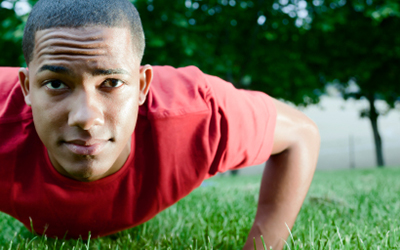



Ah, summer is here. As a student, you may be looking forward to time off from school, a summer internship or job, a few more classes, or some adventures in the sun.
In a recent Student Health 101 survey, 88 percent of respondents said they want to “get into shape” for summer. But this means more than aiming for a certain size of bathing suit. It’s about building strength and endurance so that you can enjoy summer activities and maintain your health.
Staying active will keep your energy levels high and your brain clear to focus on whatever your goals are for the next few months and beyond.
Talia shares her motivation for exercising. (MP4, 02:07)
While some students like to get their physical activity in a gym, many others choose options that build on their interests or can be done at home or right outside their doors.
Many students like it when they get exercise “by accident” through activities that are fun. For example, an impromptu game on the campus green space or a walk around town on a sunny day can really get your heart pumping.
Other students choose activities that they enjoy, but take a more deliberate approach. Meghan B., a third-year student at Carleton University in Ottawa, Ontario, credits her healthy lifestyle to swimming and volleyball. She says, “With volleyball, I have regular practices and games, which help me stay active.”

Cardio
The Canadian Society for Exercise Physiology (CSEP) suggests that adults should engage in 30 minutes or more of moderately intense physical activity on most days. You know an exercise is moderately intense when it raises your heart rate and causes you to sweat. Another rule of thumb for figuring out the intensity of your workout is to test your ability to talk. If you’re working really hard, you won’t be able to carry on a conversation.
What makes this recommendation very doable is the fact that the total goal–of about 2.5 hours a week–can be broken down into increments that fit your schedule. Plus, things you already enjoy doing (or have to do, like rake leaves or walk around campus to get to classes) can contribute to your efforts.
The aim is to push your body to a point where the heart is working hard to supply your cells with oxygen and energy. Aerobic exercise can help you reduce stress, strengthen your immune system, manage your weight, and improve endurance. Some examples are fast walking, biking, swimming, dancing, water aerobics, and hiking.
Strength Training
It’s also important to do activities that build muscle strength. Instead of focusing on heart rate and pulse, as cardio does, this kind of training strengthens specific muscle groups through repetitive exercises.
The CSEP recommends that adults train all of the major muscle groups at least two days each week. Dean M., a personal trainer and fourth-year kinesiology student at the University of Ontario Institute of Technology in Oshawa, explains, “It’s important to also do activities like yoga and Pilates, which complement building strength and promote flexibility, coordination, and core stability.”
Strengthening your muscles doesn’t have to mean aiming for a bodybuilder’s physique. Rositta Peric, a certified personal trainer in Ottawa, says, “As you get stronger, you tend to build more muscle fibre, but that doesn’t always mean you’re going to have a lot of bulky muscles.”
Exercises that use your own body weight, resistance, or weighted materials all contribute to a leaner body, more efficient energy usage (calorie burning), increased bone density, and improved balance.
There are two main models of strength training:
For example, you could do bicep curls with 2-lb. weights, lifting them 15 times (15 repetitions or “reps”) on each side and do this 4 times (4 “sets”). Or, you might use 10-lb. weights and lift them for 2 sets of 10 reps on each side.
The CSEP suggests working until your muscles are fatigued but you’re not exhausted. Peric says, “For heavy weights, you should generally wait 2–3 minutes between sets. If you use a less taxing amount, wait 60–90 seconds. Taking a break ensures that you get the proper blood supply to your muscles.”
It’s also recommended that you wait at least 48 hours between sessions of strength training. As Peric explains, “Rest is always the best! You need good nutrition and the proper amount of sleep so your body has time to recover.”

There are a few simple strength-training exercises that can be done just about anywhere. Adjust the amount of weight you use, the number of reps, and other modifications based on your individual needs. For example, you can do an exercise for a particular amount of time rather than a certain number of sets.
To fit exercise into your day, create a schedule that works for you. For example, you could focus on your arms and abs on Mondays and Wednesdays, and your legs and gluteals on Tuesdays and Thursdays. Aleksi M., a third-year student at the University of British Columbia in Vancouver, shares, “Knowing what I have to do each week definitely makes me exercise more often.”
Sticking with a consistent schedule of physical activity will help you make progressive gains and get into an exercise habit. Before long you’ll feel stronger and more energized for all of your summer activities.
JESSICA WONG is a third-year Journalism student at Carleton University.
Materials Needed:
During all exercises, engage your abdominal and gluteal muscles to keep strain off your back and strengthen your core.
Arms
Bicep Curls
Lateral Raises
Abs
The Plank
Bicycles
Legs & Gluteal Muscles
Leg Raises
The Classic Lunge
Squats
Rositta Peric, a personal trainer in Ottawa, recommends alternating between bursts of high-intensity exercise and periods of lighter exercise. “Interval training with weights will help you get stronger,” she says.
Keep in mind that these are just a few options. For more, check out the FitnessU section of Student Health 101 or search online for workouts that look fun to you and focus on the areas you’d like to strengthen.


